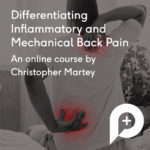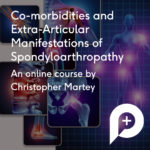Immerse yourself in the world of rheumatology and get to know the different types of spondyloarthropathies
Spondyloarthropathy is an umbrella term for a group of inflammatory diseases that are progressive and painful. These conditions affect the axial and peripheral skeletons, tendons and ligaments, and other organs such as the skin, intestines, and eyes. Spondyloarthropathies tend to affect younger people, who usually develop before the age of 45. Because they have so far-reaching effects, it is important to be able to distinguish these inflammatory conditions from one another and from other types of back pain.
Unfortunately, diagnosis and treatment are often delayed because they are difficult to distinguish. leads to poorer prognoses and results for patients, which could easily have been prevented.
Learn with the expert Chris Martey
Chris works as a first-contact musculoskeletal (FCP) physical therapist in general practitioners' offices in the south west of England and is passionate about health promotion. He sits on the board of trustees of the Alliance for Arthritis and the Musculoskeletal System (ARMA) and has a special interest in the medical specialty of rheumatology, in particular in the inflammatory disease of adults associated with spondyloarthritis.
Chris has lectured nationally on spondyloarthritis, is published in the field and is a member of the Executive Committee of the British Society for Spondyloarthritis (BRITSpA). He is an expert in this field and Physioplus members can access his courses to improve the timeliness of diagnosis and treatment of these patients .
Take part in the overview of the spondyloarthropathy course
Courses in the program
Diagnosis and classification of spondyloarthropathies
Spondyloarthropathy is a chronic form of inflammatory arthritis with axial and peripheral manifestations as well as extra-articular features. Due to its different presentation, the diagnosis of spondyloarthropathy can be a lengthy and complex process. While only rheumatologists can diagnose spondyloarthropathy, it's important that other clinicians, including physical therapists, identify features consistent with these conditions to ensure an immediate referral. This course introduces some of the key classification systems that have been developed for differential diagnosis to improve the early detection of spondyloarthropathy.
Learn how to apply CASPAR and ASAS criteria.
Differentiation between inflammatory and mechanical back pain
 Back pain is a common disease in physiotherapy practice. The majority of patients are classified as unspecific. However, it is important to be able to identify patients outside this category, including those whose back pain is of inflammatory origin. This course, the second in a series of spondyloarthropathy courses, introduces evidence-based methods that you can use to distinguish between these different types of back pain.
Back pain is a common disease in physiotherapy practice. The majority of patients are classified as unspecific. However, it is important to be able to identify patients outside this category, including those whose back pain is of inflammatory origin. This course, the second in a series of spondyloarthropathy courses, introduces evidence-based methods that you can use to distinguish between these different types of back pain.
Improve your differential diagnoses
Comorbidities and extra-articular manifestations of spondyloarthropathy
 Spondyloarthropathies are seronegative inflammatory conditions that have far-reaching effects beyond axial and peripheral joint pain. These conditions are associated with various comorbidities, ranging from an increased risk of cardiovascular disease to osteoporosis and extra-articular features such as skin, eye, and intestinal diseases. These conditions can significantly increase the disease burden on those with spondyloarthropathy. Early detection, differential diagnosis, and appropriate management are therefore essential for these patients.
Spondyloarthropathies are seronegative inflammatory conditions that have far-reaching effects beyond axial and peripheral joint pain. These conditions are associated with various comorbidities, ranging from an increased risk of cardiovascular disease to osteoporosis and extra-articular features such as skin, eye, and intestinal diseases. These conditions can significantly increase the disease burden on those with spondyloarthropathy. Early detection, differential diagnosis, and appropriate management are therefore essential for these patients.
Learn more about extra-articular manifestations
Treatment of spondyloarthropathy
 Spondyloarthropathy is an umbrella term for a group of seronegative inflammatory conditions with axial and peripheral symptoms. The main goal of treatment is to reduce inflammation. Problems such as pain, stiffness, fatigue, insomnia, depression, decreased physical activity, and an increased risk of cardiovascular disease also need to be addressed. Various pharmacological and non-pharmacological treatments are available for spondyloarthropathy, including exercise therapy. Physiotherapists and occupational therapists play a key role in managing these chronic conditions, from the early to late stages of the disease.
Spondyloarthropathy is an umbrella term for a group of seronegative inflammatory conditions with axial and peripheral symptoms. The main goal of treatment is to reduce inflammation. Problems such as pain, stiffness, fatigue, insomnia, depression, decreased physical activity, and an increased risk of cardiovascular disease also need to be addressed. Various pharmacological and non-pharmacological treatments are available for spondyloarthropathy, including exercise therapy. Physiotherapists and occupational therapists play a key role in managing these chronic conditions, from the early to late stages of the disease.
Learn to treat spondyloarthropathy